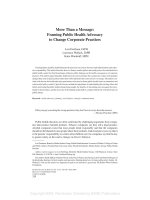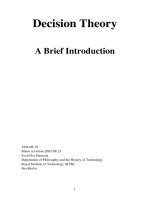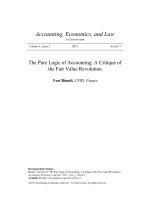More Than a Numbers Game: A Brief Histor y of Accounting pdf
Bạn đang xem bản rút gọn của tài liệu. Xem và tải ngay bản đầy đủ của tài liệu tại đây (1.05 MB, 258 trang )
More Than a
Numbers Game
A Brief History of Accounting
Thomas A. King
John Wiley & Sons, Inc.
ffirs.qxd 7/20/06 1:40 PM Page iii
ffirs.qxd 7/20/06 1:40 PM Page ii
More Than a
Numbers Game
ffirs.qxd 7/20/06 1:40 PM Page i
ffirs.qxd 7/20/06 1:40 PM Page ii
More Than a
Numbers Game
A Brief History of Accounting
Thomas A. King
John Wiley & Sons, Inc.
ffirs.qxd 7/20/06 1:40 PM Page iii
Copyright © 2006 by Thomas A. King. All rights reserved.
Published by John Wiley & Sons, Inc., Hoboken, New Jersey.
Published simultaneously in Canada.
No part of this publication may be reproduced, stored in a retrieval system, or
transmitted in any form or by any means, electronic, mechanical, photocopying,
recording, scanning, or otherwise, except as permitted under Section 107 or 108
of the 1976 United States Copyright Act, without either the prior written
permission of the Publisher, or authorization through payment of the
appropriate per-copy fee to the Copyright Clearance Center, Inc.,
222 Rosewood Drive, Danvers, MA 01923, (978) 750-8400, fax (978) 646-8600,
or on the web at www.copyright.com. Requests to the Publisher for permission
should be addressed to the Permissions Department, John Wiley & Sons, Inc.,
111 River Street, Hoboken, NJ 07030, (201) 748-6011, fax (201) 748-6008, or
online at />Limit of Liability/Disclaimer of Warranty: While the publisher and author have
used their best efforts in preparing this book, they make no representations or
warranties with respect to the accuracy or completeness of the contents of this
book and specifically disclaim any implied warranties of merchantability or
fitness for a particular purpose. No warranty may be created or extended by sales
representatives or written sales materials. The advice and strategies contained
herein may not be suitable for your situation. You should consult with a
professional where appropriate. Neither the publisher nor author shall be liable
for any loss of profit or any other commercial damages, including but not limited
to special, incidental, consequential, or other damages.
For general information on our other products and services or for technical
support, please contact our Customer Care Department within the United
States at (800) 762-2974, outside the United States at (317) 572-3993 or
fax (317) 572-4002.
Wiley also publishes its books in a variety of electronic formats. Some content
that appears in print may not be available in electronic books. For more
information about Wiley products, visit our web site at www.wiley.com.
Library of Congress Cataloging-in-Publication Data:
King, Thomas A., 1960–
More than a numbers game : a brief history of accounting / Thomas A. King.
p. cm.
Includes bibliographical references and index.
ISBN-13: 978-0-470-00873-7 (cloth)
ISBN-10: 0-470-00873-3 (cloth)
1. Accounting—United States—History. 2. Accounting—Standards—
United States—History. 3. Accounting—Law and legislation—United
States—History. I. Title. II. Series.
HF5616.U5K53 2006
657.0973—dc22
2005037200
Printed in the United States of America.
10987654321
ffirs.qxd 7/20/06 1:40 PM Page iv
To Yvonne, Amanda, Alex, and Emily
ffirs.qxd 7/20/06 1:40 PM Page v
ffirs.qxd 7/20/06 1:40 PM Page vi
CONTENTS
About the Cover ix
Preface xi
1 Double-Entry 1
2 Railroads 13
3 Taxes 23
4 Costs 41
5 Disclosure 55
6 Standards 71
7 Science 89
8 Inflation 103
9 Volatility 115
10 Intangibles 131
11 Debt 145
vii
ftoc.qxd 7/20/06 1:42 PM Page vii
12 Options 159
13 Earnings 171
14 SOX 187
15 Epilogue 207
Notes 213
Bibliography 223
Index 235
About the Author 242
viii CONTENTS
ftoc.qxd 7/20/06 1:42 PM Page viii
ABOUT THE COVER
T
he U.S. Postal Service and predecessor Post Office De-
partment have released four thousand stamps to remem-
ber key people, places, and events in U.S. history. Stamps
offer tiny windows into America’s past. Six examples, presented
from upper left to lower right on this book’s cover, commemo-
rate events discussed in this book.
Scott #1920. Issued September 21, 1987, to honor the 100th an-
niversary of the founding of the trade group that would become
the American Institute of Certified Public Accountants. 22c; mul-
ticolored. Pen tip and ledger book, designed by Lou Nolan.
Scott #2361. Issued June 16, 1981, to observe the 100th anniver-
sary of the founding of the Wharton School of Business. 18c;
blue and black. Portrait of Joseph Wharton, designed by
Rudolph de Harak.
ix
Source: Scott Specialized Catalogue of US Stamps & Covers. Sidney, OH: Scott Pub-
lishing Company, 2000.
fbetw.qxd 7/20/06 1:54 PM Page ix
Scott #3184o. Issued May 28, 1998, as a pane of 15 stamps in the
Celebrate the Century series’ 1920s collection. Stock market crash of
1929. 32c; multicolored. Torn stock certificate, designed by Carl
Herrman. Printed by Ashton-Potter (USA) Ltd.
Scott #922. Issued May 10, 1944, to celebrate the 75th anniver-
sary of the completion of the first transcontinental railroad. 3c;
violet. Based on Golden Spike Ceremony, painted by John McQuar-
rie.
Scott #1380. Issued September 22, 1969, to observe the 150th an-
niversary of the Dartmouth College case, where alumnus Daniel
Webster argued before the Supreme Court that the government
could not impair private contracts. 6c; green. Daniel Webster and
Dartmouth Hall, designed by John R. Scotford Jr.
Scott #2630. Issued May 17, 1992, to honor the 200th anniversary
of the founding of the market that became the New York Stock
Exchange. 29c; green, red, and black. Stylized stock certificate,
designed by Richard Sheaff. Printed by the Jeffries Bank Note
Company for the American Bank Note Company.
x ABOUT THE COVER
fbetw.qxd 7/20/06 1:54 PM Page x
PREFACE
T
he world suffers no shortage of accounting texts. The
many I’ve read over the past 25 years have helped me au-
dit, prepare, use, and explain corporate financial state-
ments. Missing in this lettered journey has been a work that
provides context for accounting’s six divisive issues: inflation,
volatility, intangibles, debt, options, and earnings. A brief history
of accounting can fill this void.
Students and practitioners study textbooks designed to ex-
plain the how’s of accounting. Readers consequently learn the
mechanics of, say, calculating earnings per share without under-
standing that statement preparers and users often work at cross-
purposes to cope with nonrecurring items and costs of
equity-based compensation. This short book’s contribution is to
discuss the major why’s of accounting practice.
More Than a Numbers Game was inspired by Arthur Levitt’s
landmark 1998 speech delivered at New York University. The Se-
curities and Exchange Commission chairman described the too-
little-challenged custom of earnings management and presaged
the breakdown in U.S. corporate accounting three years later.
Somehow, over a hundred-year period, accounting morphed
xi
fpref.qxd 7/20/06 1:56 PM Page xi
from a tool used by American railroad managers to communicate
with absent British investors into an enabler of corporate fraud.
How this happened makes for a good story.
This book is not another description of accounting scandals
but rather a history of ideas. Each chapter covers a controversial
topic that emerged over the past century. Historical background
and discussion of people involved give relevance to these concepts.
I show how economics, finance, law, and business custom con-
tributed to accounting’s development. Use of anecdote, example,
and light humor make More Than a Numbers Game easy to read.
Thoughts presented come from a career spent working with
accounting information. I have designed and used cost account-
ing systems in manufacturing and service settings, argued with
tax and regulatory authorities, and participated in design of
compensation systems. Experience has shown me how numbers
on paper influence careers, projects, and business prospects.
My credentials include tours of duty in financial statement
auditing (auditor at a Big Eight accounting firm), preparation
(corporate controller of a Fortune 500 firm), use (general man-
ager with profit and loss responsibility at a corporation plus
board member of a nonprofit), and explanation (accounting
teacher and investor relations officer). Perhaps most signifi-
cantly, I witnessed a major audit failure.
Accounting viewed from these perspectives taught me that
the so-called language of business is best understood as a collec-
tion of dialects. Most accounting books spend too much time on
financial reporting. Consideration of the purposes and limita-
tions of cost, tax, and regulatory accounting makes the field
more understandable to the informed layperson.
The reader who sticks with the text will be rewarded with a
thorough grounding in accounting’s major issues. By the final
chapter, he or she should be able to engage in accounting debate
on almost any topic. Accounting can be both a vocation and an
avocation. It’s fun. Really.
➣
xii PREFACE
fpref.qxd 7/20/06 1:56 PM Page xii
Book prefaces, where authors thank others, seemed vacuous un-
til I tried to put thoughts to paper. This book would not have
been possible without generous support offered by colleagues.
Marion Brakefield endured endless requests to modify charts.
John Burchard and Scott Gould tracked down arcane articles
and cases. Jeff Basch, Don Chew, and Tom Forrester provided
helpful comments to improve presentation. John Wiley & Sons’
Stacey Farkas, Bill Falloon, Pamela van Giessen, and Laura Walsh
coached me with patience as I learned about the world of pub-
lishing. Their copyeditors possess a deft touch.
Thanks also to my father, who encouraged an accounting ca-
reer. I hated my first job but slowly learned to appreciate ac-
counting’s hidden beauty. My grandfather exposed me to the
craft of history and taught there are only three ways to know
something: you experience it directly, someone tells you, or you
figure it out. He also pressed the importance of active voice,
strong verbs, and few prepositions.
The Ohio Library and Information Network, which delivered
volumes from Ohio’s college and university book collections to
our neighborhood public library branch, made research possible
in light of concurrent work and family commitments. Finally, my
superiors chose not to fire me as I devoted increasing amounts of
company time to complete this effort, a further illustration of
Michael Jensen’s agency costs.
Opinions and conclusions expressed herein represent per-
sonal views. No practitioner, academic, or regulator will agree
with all points made in subsequent pages. I took liberties con-
densing ideas and events to keep this work brief. Responsibility
for resulting errors and omissions rests with me.
Chagrin Falls, Ohio
November 2005
PREFACE xiii
fpref.qxd 7/20/06 1:56 PM Page xiii
fpref.qxd 7/20/06 1:56 PM Page xiv
1
DOUBLE-ENTRY
What advantage does he derive from the system of bookkeeping by
double-entry! It is among the finest inventions of the human mind.
—Johann Wolfgang von Goethe,
Wilhelm Meister, 1824
O
n Sunday, April 8, 1984, the phone rang in my Hoboken
apartment. A Big Eight audit manager, my boss’ boss,
shared in a raspy voice that we had an accounting crisis.
Accounting crisis? Jumbo shrimp, gunboat diplomacy, gourmet
pizza, and other snappy phrases came to mind. Hey, let’s book an-
other entry.
The manager had learned that a client had amassed a sizable
bond position and sustained adverse interest rate changes. Finan-
cial statements recently filed with the Securities and Exchange
Commission (SEC) made no mention of the investment or hold-
ing loss. One could argue that investors relying on the statements
had been misled.
My first accounting professor, New York University’s George
Sorter, taught there was no such thing as an accounting mistake.
1
ccc_king_001-012_ch01.qxd 5/31/06 1:51 PM Page 1
Estimates used to make timely journal entries create inevitable
misstatement. Errors reverse as more information comes to light.
Nothing goes wrong over the infinite life of the firm. Consistent
with Dr. Sorter’s teachings, the client’s estimates were indeed
corrected.
In addition, the firm reshuffled management, filed restated
balances, weathered unflattering publicity, and sustained an SEC
investigation. My employer paid a sizable malpractice settlement.
And I learned that sterile accounting numbers could make all
the difference in the world.
Two decades later, accounting scandal rocked American busi-
ness. In just 12 months industry giants Enron, Global Crossing,
and WorldCom imploded. Arthur Andersen & Company—their
auditor, my old employer, and once the planet’s mightiest certi-
fied public accountant (CPA) firm—ceased to exist. And Con-
gress enacted the most sweeping securities law since the Great
Depression. This spectacular meltdown sparked the following ef-
fort to chronicle American corporate accounting’s history from
the age of railroads to Sarbanes-Oxley legislation.
History tells a story, and no story can ever be complete. His-
torians must select from an infinite ocean of facts those few
deemed significant. Selections become fact only by virtue of sig-
nificance attached by authors.
1
These pages present my views of
the significant facts that created one of the largest business scan-
dals in U.S. history.
➣
Corporate financial reporting emerged in nineteenth-century
America when professionals applied quantitative methods to
qualitative endeavors. Academics blended philosophy with math-
ematics to create symbolic logic. Alfred Marshall’s Principles of
Economics (1890) organized economic thought into a mathemati-
cal framework. Emile Durkheim’s Suicide (1897) used statistics to
describe individual behavior.
2
Sociologist Max Weber considered
probability in causal explanation. Bookkeepers expressed trans-
actions in dollar values.
2 MORE THAN A NUMBERS GAME
ccc_king_001-012_ch01.qxd 5/31/06 1:51 PM Page 2
Even though accounting serves proprietorships, partner-
ships, governments, and nonprofits, this book focuses on its
use to U.S. corporations. Indefinite life, divisible ownership,
and limited liability allowed corporations to dominate Ameri-
can business by the 1890s.
3
The corporate form was so effective
in meeting society’s commercial needs that venerable organiza-
tions like Lloyd’s of London and Goldman Sachs chose to
incorporate.
4
Healthy corporations require protected property rights and
liquid capital markets. An 1819 U.S. Supreme Court decision
capped the government’s power to interfere with private agree-
ments. King George III had granted a 1769 charter to Dartmouth
College, the last college formed before the American Revolution.
Forty-six years later the New Hampshire legislature sought to
turn the private college into a state university.
Alumnus Daniel Webster, a future congressman and secretary
of state, successfully argued before Chief Justice John Marshall’s
Supreme Court that a state government had no right to modify
or impair private contracts (U.S. Constitution, Article 1, Section
10, Clause 1). Webster’s speech included the famous phrase that
Dartmouth is a small college but there are those who love it. Mar-
shall’s decision affirmed that a private organization could go
about its business without state interference.
In the 1790s a collection of merchants formed an exchange
in lower Manhattan to trade government bonds. In March 1817,
as the Dartmouth case was litigated, members drafted a constitu-
tion and named the group the New York Stock & Exchange
Board. The organization later shortened its title to the New York
Stock Exchange (NYSE). Synonymous with Wall Street, the NYSE
evolved into the world’s largest, most liquid stock market. Con-
centrating buyers and sellers provided efficient pricing and re-
duced ownership risk for equity securities.
Property rights and capital markets require a buffer from
fraud. Numbers offer some protection. Quantitative discussion
curbs management’s ability to talk its way out of problems. An ex-
ecutive I knew controlled evasive subordinates by limiting their
DOUBLE-ENTRY 3
ccc_king_001-012_ch01.qxd 5/31/06 1:51 PM Page 3
responses to yes, no, or a number. The U.S. government offered
body counts as quantitative—and presumably more believable—
evidence of progress in the Vietnam War. Computer makers spew
statistics to suggest product superiority.
Accounting quantifies business communication. Financial ac-
counting, the primary dialect, allows lenders and investors to as-
sess the amount, timing, and certainty of a corporation’s future
cash flows. Creditors want to know if they’ll get their money back;
stock investors care about whether they can expect substantial fu-
ture dividends. Financial accounting principles emerged to
match revenues with expenses and determine a corporation’s
ability to pay interest or dividends from business activity in a
given period.
With passage of U.S. income tax law, the federal government
embraced accounting to measure taxable income. Tax account-
ing mutated into a system designed to determine when a tax-
payer had the obligation and ability to pay tax bills. Companies
then needed two sets of books.
Scale-sensitive enterprises like steel producers and car manu-
facturers developed enormous infrastructures to reduce unit
costs. Massive, indirect costs could not be easily traced to individ-
ual products. Sophisticated companies developed allocation sys-
tems to ensure product prices recovered all resources consumed
in production. Healthy manufacturing firms learned to keep a
third set of books to refine cost accounting methods.
Some regulated companies then had to file reports demon-
strating solvency or compliance with government rules. These
lucky banks, insurers, utilities, and transportation firms required
a fourth set of books to maintain business licenses. The language
of business became the province of experts.
➣
Accounting rules trace to bookkeeping practices. Master taught
apprentice, and custom became precedent. Rules agreed upon in
the United States coalesced into generally accepted accounting
principles (GAAP). Not until the Great Depression did formal
4 MORE THAN A NUMBERS GAME
ccc_king_001-012_ch01.qxd 5/31/06 1:51 PM Page 4
bodies document and propose revisions to GAAP. No one has
successfully codified this amorphous rule set.
These grass roots lent financial reporting a practical bias.
The organization to emerge as the leading force for accounting
standards was the trade group representing independent audi-
tors, the American Institute of Certified Public Accountants
(AICPA). Ideas put forth by accounting educators and financial
statement preparers carried less weight. Economists, who devel-
oped insight into the nature of capital markets, financial securi-
ties, and asset valuation, garnered little respect from the auditing
profession and its clients.
What did resonate was summarization. Financial account-
ing proved brilliant at condensing myriad transactions into a
single statistic, earnings per share (EPS), which could be
shared among thousands of investors. The discipline emerged
as the primary tool to communicate corporate position and
performance to absentee investors and lenders. As the U.S.
economy developed over the twentieth century, accounting
matured to summarize increasingly complex transactions in
simple terms.
Three events tainted this maturation. First, the need to col-
lect income taxes and product costing information created di-
alects. No one stepped forward to harmonize record keeping
practices among accounting’s branches. The resulting lack of
conformance, especially with tax accounting and the rise of pro
forma earnings figures, validated a Rashomon-like belief that
there was no negative consequence for reporting the same event
in varied ways.
Second, the growth of services aggregating analyst earnings
estimates led to a game where analysts and investors evaluated
the quality of a firm’s reported results by determining whether
the company met or missed consensus earnings figures. Some
management teams bowed to increasing pressure and reported a
few additional pennies per share each accounting period to
demonstrate mastery of business operations. Jimmying the books
created bigger problems.
DOUBLE-ENTRY 5
ccc_king_001-012_ch01.qxd 5/31/06 1:51 PM Page 5
Finally, statement preparers ignored advancements in eco-
nomics. University researchers developed tools to understand
consequences of business transactions and reporting principles.
Practitioners brushed off this work and developed misguided
judgments about market behavior.
When certain firms’ stock prices became overvalued in the
1990s, these three forces combined to create pathological fear
among statement preparers of reporting volatile earnings and
showing debt on the balance sheet. Resulting actions created a
train wreck in 2002.
➣
Accounting begins with the balance sheet, a two-sided chart pre-
senting assets used to accomplish a firm’s objectives together
with claims outsiders hold on those assets. Double-entry book-
keeping, a term eluding satisfactory definition, developed to
show that changes in assets influence claims on those assets. Ger-
man philosopher Oswald Spengler wrote in The Decline of the West
(1928) that the invention of double-entry bookkeeping was the
decisive event in European economic history.
Double-entry bookkeeping does not affirm symmetry of the
universe. The tool simply emerged as a practical way to keep
track of an organization’s resources. Entering transactions twice
provides a check to ensure computational accuracy and allows
managers to track asset ownership. Entrepreneurs use other
means to track businesses. An accounting professor even demon-
strated feasibility of a triple-entry bookkeeping system.
In a double-entry world, assets must equal the sum of liabili-
ties and shareholders’ equity. What we have equals what we owe
plus what we own. Equity represents owners’ interests in assets af-
ter satisfaction of all outside claims. In liquidation, a firm would
sell assets, pay liabilities, and distribute any remainder to owners.
Figure 1.1 illustrates this accounting identity.
Accounting principles turn on three concepts: recognition,
valuation, and classification. Recognition determines when a tool
or claim should be recorded on the books. Valuation ascribes a
6 MORE THAN A NUMBERS GAME
ccc_king_001-012_ch01.qxd 5/31/06 1:51 PM Page 6
dollar measurement to that tool or claim. Classification places
the item somewhere in the geography of the balance sheet.
Assets generally appear on the balance sheet when a firm
obtains rights to tools as a consequence of previous transac-
tions. Accounting principles value most assets at historical cost
with a downward revision, if appropriate, to cover deterioration
or impairment. The cost convention arose from the need to
place a monetary value on a future benefit with some degree of
certainty.
Any veteran of garage sales recognizes the range of opinion
associated with asset values. Accountants turned to historical
cost, the cash used to buy the asset, as a solution. This sum repre-
sents what a willing buyer and seller agreed upon in an actual
transaction. Auditors could verify this balance easily. Valuation of
financial instruments, whose prices could be easily observed in
security markets, began to be adjusted from acquisition cost to
market quote.
Since 1894 the U.S. convention has been to classify assets in de-
scending order of liquidity in order to make balance sheets more
useful to creditors.
5
Assets that could not be easily converted into
DOUBLE-ENTRY 7
Tools
Owners of
Tools
Intangible Assets
Inventory
Deferred Taxes Payable
Accounts Payable
Assets
Liabilities & Equity
Cash and Securities
Accounts Receivable
Property, Plant,
and Equipment
Debt
Shareholders’ Equity
Contributed Capital
Beginning Retained Earnings
+ Income
– Dividends
Ending Retained Earnings
Capitalized Lease
Obligations
Figure 1.1 Balance Sheet Displays Claims on a Firm’s Assets
ccc_king_001-012_ch01.qxd 5/31/06 1:51 PM Page 7
cash appeared further down the balance sheet’s left-hand side.
Suppliers, banks, and bondholders looked for liquid assets as po-
tential collateral to secure loans to corporations.
Liabilities, the balances appearing on the top right-hand side
of the balance sheet, represent obligations owed to outsiders. Ac-
countants recognize liabilities when corporations receive some-
thing of value in exchange for a promise to pay money or
provide goods or services.
Accountants value long-term financial obligations with pre-
dictable disbursements, such as bonds and lease contracts, as the
sum of discounted future payments. As with assets, accountants
classify liabilities in decreasing order of liquidity: Payables due
within 30 days appear near the top while long-term bonds appear
near the bottom.
Shareholders’ equity, representing the difference between as-
sets and liabilities, appears in U.S. balance sheets’ lower right-
hand corner and constitutes owners’ residual claim on assets. An
early classification issue was apportioning equity between in-
vestors’ original capital contributions and retained earnings
from subsequent operations. Firms generally could pay dividends
only out of retained earnings.
Debt and shareholders’ equity, collectively known as capi-
tal, make up a firm’s long-term financing. Bondholders and
stock investors trade divisible pieces of these balances in capi-
tal markets.
Railroads, heavy users of debt financing in the late 1800s,
were the first American firms to issue balance sheets to absentee
creditors. Balance sheets served as a tool to let bondholders eval-
uate stewardship and determine whether management stole or
misused corporate assets.
➣
Financial accounting’s second major deliverable is the income
statement. Revenue and expense accounts represent temporary
extensions of the retained earnings section of shareholders’ eq-
uity. Revenue shows increases and expenses show decreases in re-
8 MORE THAN A NUMBERS GAME
ccc_king_001-012_ch01.qxd 5/31/06 1:51 PM Page 8
tained earnings within an accounting period.
6
Revenues arise
from transactions that increase a company’s assets. Expenses rep-
resent consumption of assets to bring in revenue. Any excess of
revenues over expenses plus distributions to owners adds to re-
tained earnings.
Just as historical cost represents the bedrock of asset valua-
tion, matching is the foundation of the income statement. In-
stead of comparing inflows and outflows of cash, accountants use
accruals to align efforts and accomplishments over an account-
ing period. Management estimates used to match revenues and
expenses (e.g., provisions for bad debt, obsolete inventory, or fu-
ture income taxes) convey information valuable to investors and
creditors.
Perhaps the most important accounting decision a book-
keeper can make is determining whether resources consumed to-
day will generate revenue in future accounting periods. If the
answer is yes, then the charge should be capitalized and classified
on the balance sheet as an asset. If not, then the balance should
be expensed, flow through the income statement, and accumulate
as a reduction in retained earnings. This issue will reappear in
subsequent chapters.
The stylized income statement shown in Table 1.1 shows how
revenues and expenses influence the retained earnings account
in successive balance sheets. The excess of inflows over outflows
provides a measure of income for one accounting period and at-
tempts to identify the cash a firm can expect to realize from
transactions reported in that period. No accounting theorist or
practitioner has yet developed a widely accepted definition for
income or bottom line.
With increasing stock ownership in the 1920s, the income
statement displaced the balance sheet as the primary financial
statement. Lenders want to know if they will get their money back.
Balance sheets show potential collateral and existence of other
claims. Shareholders care about a corporation’s ability to pay fu-
ture dividends through growth and improved margins. Whereas
balance sheets supported creditor evaluation of management
DOUBLE-ENTRY 9
ccc_king_001-012_ch01.qxd 5/31/06 1:51 PM Page 9









